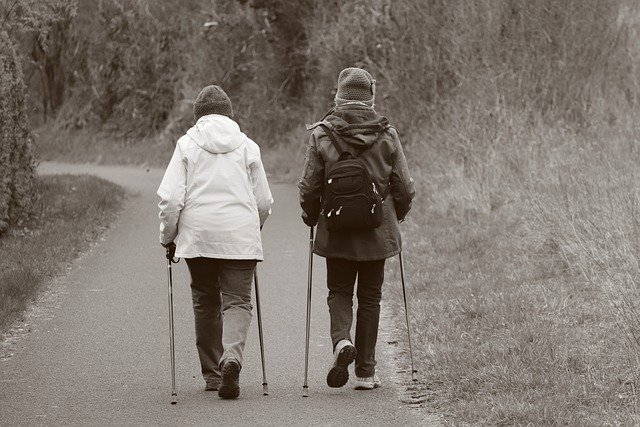Table of Contents
Some links on posts are affiliate links and will earn us a commission from qualifying purchases
It seems these days that there are more and more people who have tried using walking poles (also known as trekking or hiking poles), and liked them, so they continue to walk with them. So we thought we should look into this for you.
Why use walking poles? There are 3 main benefits for using walking poles – they aid people walking by providing support and balance, especially on snow or uneven ground; they make walking easier by easing the stress on joints; and they also help to aid propulsion.
Why and when were walking poles invented?
Walking poles as they are currently known were designed by skiers who wanted to maintain their fitness levels in the summer months when they were unable to ski any more.
This is known as Nordic walking, a term first defined in 1979 by Mauri Repo. The first walking poles as we know them were marketed in 1988 by Exerstrider in the US.
How to use walking poles
When using walking poles, you hold one in each hand using the specially designed grip handle. Place your hand through the loop from below, and then you can lightly grip the handles. There’s no need to grip the handles tightly. Don’t forget to take off the rubber cap on the tip of your poles, to expose the strengthened tip.
When you are starting to grip your walking pole, and the pole is just touching the ground, your arm should be about 90 degrees at the elbow. Your pole length may need adjusting if your elbow differs from this angle by much.
With opposite hands from feet, or in other words left foot forward means the right hand, you plant the pole a little in front of you, and pushing through them follow through with your stride. It’s important not to stretch out too far ahead of you.
Angle the pole slightly, with the handle further forward than the point, say 70 degrees or so. This will enable you to push through them more, whereas if they were straight (90 degrees) then you are getting very little propulsion forward.
It’s basically the same as walking but it also engages your upper body more. Because of this, it’s important to build up in mileage when you first use walking poles, so that your shoulders get time to recover.
Pros of using walking poles
Support and balance
Someone using walking poles will be able to use these for support and balance. This is particularly helpful for elderly walkers but can assist anyone, particularly on snowy or uneven ground.
They also are great for walking up and down steep hills or steps – set them a little wider so you can feel more comfortable and secure.
If you are a little unsteady on your feet but would still like to continue to walk outside in the fresh air, then walking poles are almost a must for you. They will help give you the confidence that you are looking for.
Make walking easier
Using walking poles can help spread the weight burden of any rucksack and gear that you are carrying, as you now have 4 points of contact with the ground, through which this weight is distributed.
They also help the impact on your knees and hip joints. Whilst this will aid you in your walks now, it is also a long term benefit as your joints should be in a better state as you get older, and thus enable you to walk for more years. There’s also less stress on your muscles and ligaments, which should mean less wear and tear on your body.
If you already suffer with aches and pains in your joints, then walking poles will help you immensely.
Propulsion
As you push the walking poles into the ground at an angle and they help propel you forward, you will be able to cover longer distances easier. Whilst each individual step may not amount to much movement forward, multiply this over many miles and the benefit is great.
Using a set of walking poles properly will enable you to hike further and quicker than before. They will also help you use more of your body, and help build upper body strength.
Cons of using walking poles
Bad form when using walking poles can actually cause more strain – make sure you are using them correctly and ensure that you are standing up straight. When going uphill, avoid the temptation to lean forward on your poles, as you will just be transferring all your weight, including backpack, through your arms. Your leg muscles are the biggest in your body, so stand straight and ensure the weight goes through those as intended.
The steel carbide tips can cause damage to paths and plants whilst walking. Obviously if you are walking along a path with lots of delicate plants, then please take care where you place your pole tips.
Conclusion – Why use walking poles
Used correctly, walking poles can be a great addition to your walking gear. They will aid you to walk longer and quicker, with less strain on your joints and muscles. They will also help you with balance and support.
What next?
Best budget walking poles – 2020 buyers guide
Recent Posts
Heading out for a hike? The weather can be your best friend or your worst enemy. Knowing what the sky has in store for you is vital for a safe and enjoyable trip. Being prepared for sudden changes,...
Going for a hike is a fantastic way to enjoy nature, but it's super important to be ready for anything. Knowing some basic first aid and having the right gear can turn a small bump in the road into...


